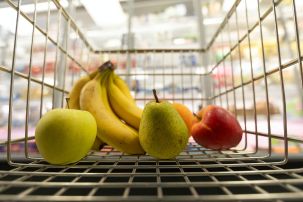Lesson summary
Students build their understanding of the effect food choices have on our health and the health of our environment. They inspect the amount of packaging in their lunchbox then plan and undertake a rubbish free lunch to reduce the amount of schoolyard waste.
Learning intentions:
Students will...
- understand the role and impact of food packaging
- begin to take responsibility for unwanted food packaging
- rethink the concept of waste and brainstorm ways to 'close the loop'.
Success criteria:
Students can...
- explain the impact of food packaging on our environment
- make a plan for reducing the amount of waste they produce.
Lesson guides and printables
Lesson details
Curriculum mapping
Australian Curriculum content descriptions:
Year 5 Science:
- Science involves testing predictions by gathering data and using evidence to develop explanations of events and phenomena (ACSHE081)
- Scientific knowledge is used to inform personal and community decisions (ACSHE217)
- Use equipment and materials safely, identifying potential risks (ACSIS088)
Year 6 Science:
- Science involves testing predictions by gathering data and using evidence to develop explanations of events and phenomena (ACSHE098)
- Scientific knowledge is used to inform personal and community decisions (ACSHE220)
- Use equipment and materials safely, identifying potential risks (ACSIS105)
Year 7 Science:
- Some of Earth’s resources are renewable, but others are non-renewable (ACSSU116)
- Collaboratively and individually plan and conduct a range of investigation types, including fieldwork and experiments, ensuring safety and ethical guidelines are followed (ACSIS125)
Year 8 Science:
- Collaboratively and individually plan and conduct a range of investigation types, including fieldwork and experiments, ensuring safety and ethical guidelines are followed (ACSIS140)
- Construct and use a range of representations, including graphs, keys and models to represent and analyse patterns or relationships, including using digital technologies as appropriate (ACSIS144)
- Summarise data, from students’ own investigations and secondary sources, and use scientific understanding to identify relationships and draw conclusions (ACSIS145)
Syllabus outcomes: ST3-4WS, ST3-6PW, SC4-5WS, SC4-6WS, SC4-7WS, SC4-12ES.
General capabilities: Critical and creative thinking.
Cross-curriculum priority: Sustainability OI.3, OI.8.
Time required: 2 – 4 lessons.
Resources required
- Gloves and tongs for collecting waste
- One copy of the Student Worksheet for each student (or invite students to create their own).
Skills
This lesson is designed to build students’ competencies in the following skills:
- Community engagement
- Communication
- Critical thinking
- Creativity
- Problem solving
Additional info
Following this lesson plan is an ideal way for your school to take part in Schools Clean Up Day or a Clean Up on any day of the year. You’ll be joining thousands of amazing teachers in making a difference and creating positive environmental change.


Welcome back!
Don't have an account yet?
Log in with:
By signing up to Cool.org you consent and agree to Cool's privacy policy to
store, manage and process your personal information. To read more, please see
our privacy policy here(Opens in new tab).
Create your free Cool.org account.
Many of our resources are free, with an option to upgrade to Cool+ for premium content.
Already have an account?
Sign up with:
By signing up to Cool.org you consent and agree to Cool's privacy policy to
store, manage and process your personal information. To read more, please see
our privacy policy here(Opens in new tab).